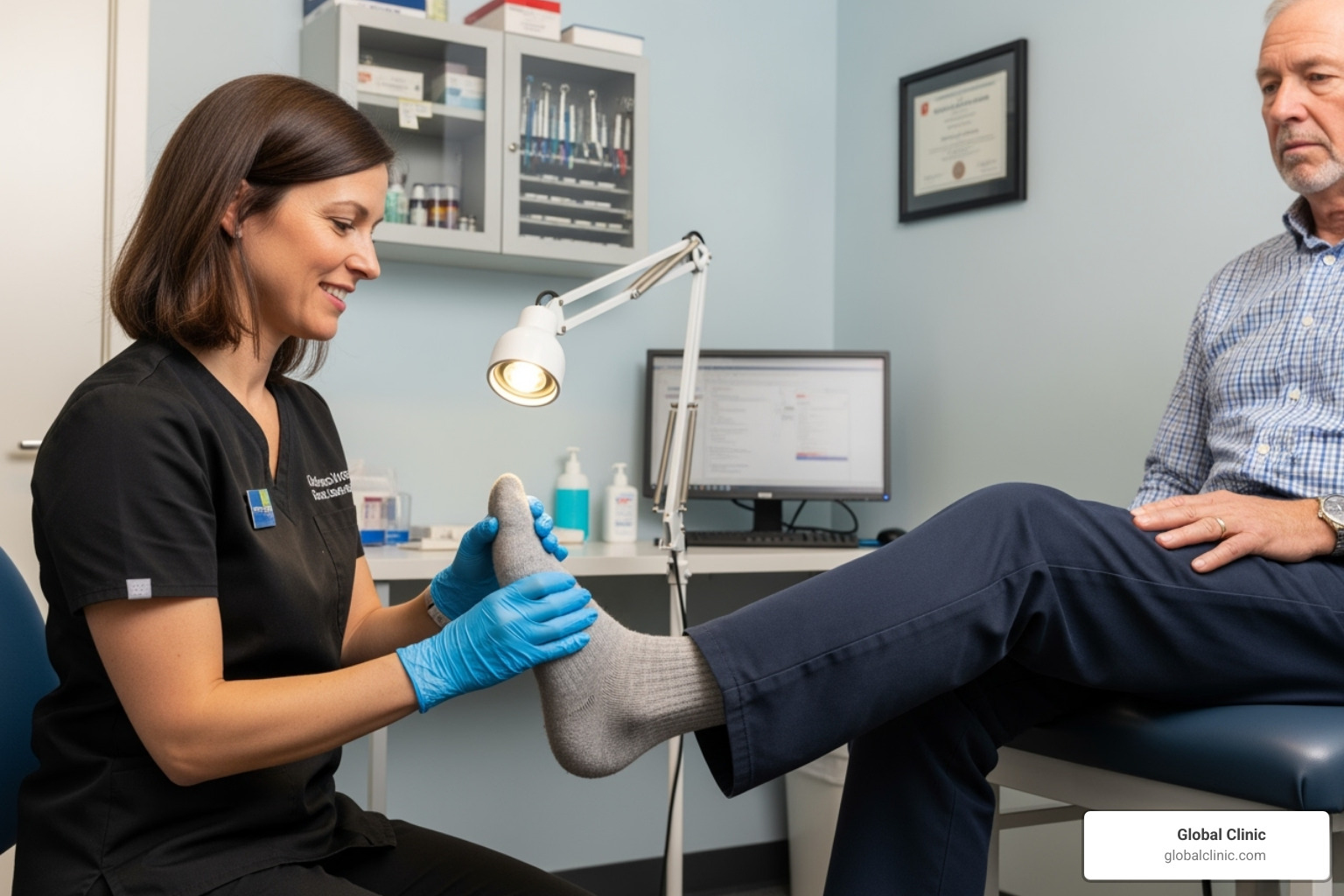Your Guide to Foot and Ankle Specialists
What is a foot doctor called? The answer is a podiatrist. This medical professional specializes in diagnosing and treating conditions affecting your feet, ankles, and lower legs.
Quick Answer:
- Primary term: Podiatrist (Doctor of Podiatric Medicine – DPM)
- Alternative terms: Foot and ankle surgeon, podiatric physician
- Outdated term: Chiropodist (still used in some countries)
- Training: 4 years undergraduate + 4 years podiatric medical school + 3-4 years residency
By age 50, your feet will have carried you an average of 75,000 miles. With 26 bones, 33 joints, and over 100 muscles, tendons, and ligaments in each foot, it’s clear why these complex structures sometimes need specialized care.
Whether you have heel pain, bunions, or an ankle injury, knowing the difference between a podiatrist and an orthopedic surgeon can help you find the right treatment.
I’m Ana Vinikov, Practice Manager at Global Clinic. For years, I’ve helped patients connect with the right specialists. My experience in pain management has shown me how crucial proper foot care is for overall health and mobility.

So, What is a Foot Doctor Called? The Official Term
The simple answer to “what is a foot doctor called” is a podiatrist. A Doctor of Podiatric Medicine (DPM) specializes in everything that affects your feet, ankles, and lower legs.
Podiatrists are highly trained medical professionals who diagnose complex conditions, interpret X-rays and MRIs, prescribe medications, and perform intricate surgery. They are the go-to experts when your lower extremities need specialized attention.
Just as you’d hire an electrician for wiring, a podiatrist’s focused expertise is best for foot and ankle problems. At Global Clinic, we know proper foot care is vital for mobility. Our pain management approach often includes specialists who address issues like gait changes after an injury, which can be supported by treatments like physical therapy after a car accident.
The Podiatrist’s Education and Training
Becoming a podiatrist requires nearly a decade of rigorous, specialized medical training focused entirely on the lower extremities.
The path starts with a four-year undergraduate degree, followed by four years of podiatric medical school. During this time, students study general medicine alongside specialized courses on the foot, ankle, and lower leg, earning a DPM degree.
After graduation, they must complete a three to four-year hospital residency. This hands-on training includes rotations in general surgery, internal medicine, and emergency medicine, with a focus on developing practical diagnostic and surgical skills for the foot and ankle.
Many then pursue voluntary board certification to demonstrate advanced expertise. Finally, all podiatrists must obtain state licensure to practice, ensuring they meet strict professional standards. For more details, visit the American Association of Colleges of Podiatric Medicine.
Podiatry Subspecialties
Podiatry includes several subspecialties, allowing you to find an expert for your specific condition.
- Sports medicine podiatrists focus on athletic injuries like sprains and tendonitis, using biomechanics and custom orthotics to treat and prevent issues.
- Podiatric surgeons perform complex surgeries to correct deformities, repair fractures, and reconstruct joints.
- Pediatric podiatrists specialize in children’s foot health, treating conditions like flat feet and in-toeing to ensure proper development.
- Wound care specialists manage chronic foot wounds, often from diabetes, using advanced techniques to promote healing and prevent complications.
- Diabetic foot care specialists focus on managing neuropathy, circulation problems, and infection risks associated with diabetes.
- Podiatric rheumatologists treat inflammatory conditions like arthritis and gout in the feet and ankles, managing pain and joint deformities.
These subspecialties highlight the sophistication of modern podiatry, ensuring specialized care is available for any foot or ankle condition.
Podiatrist vs. Orthopedist: Understanding the Difference
When you have foot or ankle pain, you might wonder whether to see a podiatrist or an orthopedist. Both are excellent choices, but understanding their unique specialties helps you make the best decision.

A podiatrist (DPM) is a specialist whose entire medical training focuses exclusively on the feet, ankles, and lower legs. They have an intricate understanding of the lower extremities.
An orthopedist (MD or DO) specializes in the entire musculoskeletal system. Their training covers the whole body, giving them a broad perspective on how issues in your back or hips might cause foot pain. Many orthopedists complete fellowship training to specialize further in foot and ankle care.
Podiatrists offer deep, specialized knowledge of the foot and ankle, while orthopedists provide a broader perspective that’s useful when the problem might originate elsewhere in the body.
When to See a Podiatrist
A podiatrist is often the best first stop for problems clearly located in your foot or ankle. They are masters of foot care and understand how foot mechanics affect your whole body. Podiatrists excel at treating common foot ailments like:
- Ingrown toenails, bunions, and hammertoes
- Plantar fasciitis (sharp heel pain)
- Sports injuries like Achilles tendonitis and stress fractures
- Nerve conditions like Morton’s neuroma
- Structural issues like flat feet or high arches, often treated with custom orthotics
- Skin and nail conditions like fungal infections, corns, and warts
- Essential diabetic foot care to prevent serious complications
At Global Clinic, we’ve seen how important it is to catch foot problems early. If you’re wondering whether your symptoms warrant professional attention, check our guide on 4 Signs That It’s Time to See a Podiatrist.
When to See an Orthopedist
An orthopedist may be the right choice when your foot or ankle problem is part of a bigger picture. They excel when foot pain might be originating from your hip or back.
- For complex trauma or injuries affecting multiple body parts, an orthopedist’s broad training is valuable.
- An orthopedic surgeon is also a good choice for extremely complex reconstructive surgeries, such as major joint replacements.
- Getting a second opinion from an orthopedist can also be helpful if conservative treatments haven’t worked.
So, what is a foot doctor called for surgery?
For surgery, both a podiatric surgeon and a foot and ankle orthopedic surgeon are excellent choices.
- Podiatric surgeons are DPMs with extensive surgical residency training focused exclusively on the foot and ankle. Their expertise is laser-focused on the lower extremity.
- Foot and ankle orthopedic surgeons are MDs or DOs who completed a broad orthopedic residency, often followed by a foot and ankle surgery fellowship. They bring a broader musculoskeletal perspective to their work.
| Surgical Focus | Podiatric Surgeon (DPM) | Orthopedic Surgeon (MD/DO) |
|---|---|---|
| Training Philosophy | Deep specialization in foot/ankle only | Broad musculoskeletal training with foot/ankle focus |
| Common Procedures | Bunion surgery, hammertoe correction, plantar fascia release, fracture repair, diabetic limb salvage | Similar procedures plus complex ankle reconstruction, joint replacement |
| Approach | Often conservative-first, highly specialized foot mechanics | Broader systemic perspective, may integrate with other body systems |
Both are highly skilled. The best choice depends on your specific condition. At Global Clinic, we prioritize conservative options but work with top surgeons when an operation is necessary to ensure the best outcome.
Common Conditions a Podiatrist Treats
Podiatrists treat a vast array of conditions affecting the lower extremities that can make walking painful. They are equipped to diagnose and treat issues from your toes to your ankles.

Because our feet endure daily pressure, they are prone to many issues. Podiatrists are experts in treating everything from skin and nail problems to structural deformities and chronic pain, including:
- Heel Pain: Often caused by plantar fasciitis or heel spurs.
- Toe Deformities: Such as bunions, hammertoes, and claw toes.
- Skin and Nail Disorders: Including fungal infections, ingrown toenails, corns, and warts.
- Sports Injuries: Like sprains, strains, and stress fractures.
- Nerve Problems: Such as Morton’s neuroma.
Structural and Injury-Related Problems
Many conditions treated by podiatrists involve the foot’s physical structure or injuries from daily activity.
- Bunions: Bony bumps at the base of the big toe that can be painful and make wearing shoes difficult.
- Hammertoes: A deformity causing a toe to bend or curl downward.
- Flat Feet (Pes Planus): When the arches of the feet are flattened, which can lead to pain in the feet, ankles, and legs.
- Fractures and Sprains: Diagnosis and treatment of bone breaks and ligament injuries in the foot and ankle.
- Achilles Tendonitis: Inflammation of the tendon connecting the calf muscles to the heel bone, common in runners.
- Morton’s Neuroma: A thickening of nerve tissue between the toes, causing sharp, burning pain in the ball of the foot.
Treatments range from conservative options like custom orthotics, physical therapy, and medication to surgery when necessary.
When to see a specialist: what is a foot doctor called for?
Podiatrists also manage foot complications from systemic diseases like arthritis and diabetes, often as part of a larger healthcare team.
- Arthritis: Podiatrists manage symptoms of arthritis (including osteoarthritis, rheumatoid arthritis, and gout) in the feet and ankles. Since foot problems can affect other joints, comprehensive care is key. Learn more about managing joint pain with resources like Living Comfortably with Knee Arthritis.
- Gout: A type of arthritis causing sudden, severe pain in the big toe joint, which podiatrists can diagnose and help manage.
- Diabetes-Related Foot Care: This is a vital area of podiatry. Diabetes can cause nerve damage and poor circulation, increasing the risk of infections, ulcers, and amputation. Podiatrists provide crucial preventative care, screenings, and wound management.
- Neuropathy: Nerve damage causing numbness, tingling, or burning in the feet. Podiatrists help manage symptoms and prevent injuries that may go unnoticed.
- Wounds and Ulcers: Open sores on the feet, common in patients with diabetes or poor circulation. Podiatrists use advanced wound care to promote healing and prevent infection.
This comprehensive care highlights the podiatrist’s essential role in both foot health and overall systemic health.
Podiatrist vs. Chiropodist: A Question of Terminology
If you’ve heard the term “chiropodist,” you may wonder how it relates to a podiatrist. The answer lies in the history of foot care.

In the early to mid-20th century, the standard term for a foot specialist in the U.S. and U.K. was “chiropodist.” The word’s Greek roots—”chiro” (hand) and “pod” (foot)—hint at a time when medical specialties were less defined. For decades, chiropodist was the common term, but the evolving medical field required clearer terminology.
Why the Name Change?
The transition to “podiatrist” was driven by practical needs and professional growth.
A key reason was to avoid confusion with chiropractors, who focus on the spine. The similar names often caused mix-ups, delaying patient care.
Professional evolution was also a factor. As the field expanded to include complex surgery, the term “podiatry” (from Greek for “foot physician”) better reflected their role as medical specialists.
The shift varied by country. In the U.S., the change happened in the 1960s when the Doctor of Podiatric Medicine (DPM) degree replaced older credentials. The UK also adopted “podiatrist,” though “chiropodist” is sometimes still used. Today in the U.S., “chiropodist” is an outdated term for a podiatrist.
What is a foot doctor called in other countries?
The term for a foot doctor varies by country, reflecting different regulatory approaches.
- Canada: In some provinces like Ontario, “chiropodist” and “podiatrist” denote different scopes of practice. Podiatrists (often with U.S. DPM degrees) have broader surgical authority. You can find details at the College of Chiropodists of Ontario.
- Australia: Universally uses “podiatrist.” Practitioners complete a bachelor’s or master’s degree, with surgeons undergoing extensive additional fellowship training.
- United Kingdom: Uses “podiatrist” as the standard term. Practitioners complete a bachelor’s degree and are regulated by the Health & Care Professions Council (HCPC). Podiatric surgeons require years of additional training.
These international variations show the importance of understanding local terms when seeking care abroad. The goal is always the same: expert care to keep you moving comfortably.
Frequently Asked Questions about Foot Doctors
Here are answers to the most common questions we hear at Global Clinic about seeing a foot specialist.
Is a podiatrist a real doctor?
Yes, a podiatrist is absolutely a real doctor. They earn a Doctor of Podiatric Medicine (DPM) degree after four years of undergraduate study and four years of specialized medical school.
They then complete a mandatory three- to four-year hospital-based surgical residency, gaining hands-on experience in various medical and surgical settings. This extensive pathway qualifies them to diagnose conditions, prescribe medication, and perform surgery on the foot, ankle, and lower leg. They are licensed and held to the same high standards as other doctors.
What should I expect at my first podiatrist visit?
Your first podiatrist visit is a comprehensive appointment to give your doctor a complete picture of your foot health. Expect the following:
- Medical History: You’ll discuss your general health, medications, and specific foot concerns.
- Physical Exam: The podiatrist will examine your feet, ankles, and lower legs, checking skin, nails, joints, and range of motion.
- Gait Analysis: Your doctor will watch you walk to identify biomechanical issues.
- Imaging: X-rays may be taken in-office. An MRI or ultrasound might be recommended for more detailed views.
- Treatment Plan: You’ll leave with a clear understanding of your condition and a personalized plan.
Can a podiatrist help with more than just my feet?
Yes. While a podiatrist’s expertise is the feet and ankles, their impact often extends to the entire body. Your feet are your body’s foundation, and when they are misaligned, it can cause a chain reaction up your kinetic chain, contributing to:
- Lower leg pain: Issues like shin splints or calf pain.
- Knee pain: Misalignment from conditions like flat feet can stress the knee joints.
- Hip and back pain: Imbalances can cause your hips to tilt and your spine to compensate, leading to discomfort.
At Global Clinic, our comprehensive pain management approach recognizes this connection. By correcting foot issues with treatments like custom orthotics, podiatrists can improve overall body alignment and reduce pain. Good foot health is crucial for staying active and supports your entire body. Proper foot care enables safe exercise at any age, a topic we cover in our article on Gentle Exercise for Seniors to Stay Active and Healthy.
Take the Right Step for Your Foot Health
We hope this guide has clarified that a podiatrist is the modern term for a foot doctor. These specialists play a vital role in keeping you mobile and pain-free.
Podiatrists earn a Doctor of Podiatric Medicine (DPM) degree through rigorous training. While the older term “chiropodist” is still used in some places, “podiatrist” better reflects their comprehensive medical and surgical expertise.
Your feet are remarkable structures. By age 50, you’ll have walked about 75,000 miles. With 26 bones and 33 joints in each foot, they deserve specialized attention.
Never ignore foot pain. A minor ache can become a serious issue affecting your knees, hips, and back, impacting your mobility and quality of life. Whether you have an ingrown toenail, diabetic foot complications, or a sports injury, a podiatrist can make all the difference.
For over 20 years, Global Clinic has helped Northern Chicago residents stay active. We know foot and ankle pain affects your whole body. Our approach is comprehensive and personalized, using innovative treatments like physical therapy, chiropractic care, and regenerative medicine. Our state-of-the-art facility offers solutions to address the root cause of your pain. We provide effective, affordable care to help you return to the activities you love.
Don’t let foot pain sideline you. If you have persistent pain or changes in your walk, it’s time to take action. Our guide on the 4 Signs That It’s Time to See a Podiatrist can help. Invest in your mobility and take the first step toward better foot health today.


